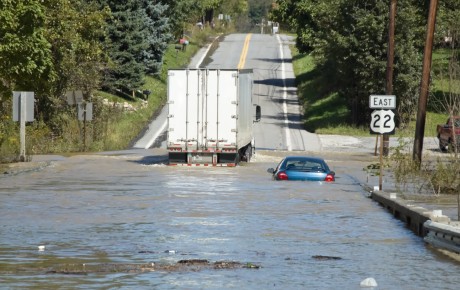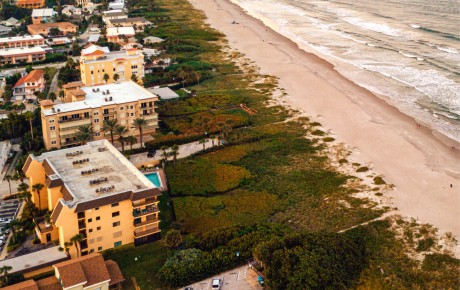
Just building walls won’t keep water out: how cities and urban areas need innovation to meet the flood risk challenge
1 in 50 people and 1 in 35 properties from 32 coastal cities in the US could face significant flooding by 2050 according to recent research published in the journal Nature. It’s a stark warning of the potential dangers from climate change, rising sea levels, and how urban areas need to consider how best they will mitigate their potential flood risk. But will traditional flood management solutions meet the challenge?
Following Hurricane Sandy’s devastation in 2012 where nearly 90,000 buildings were flooded in New York, a US$52.6 billion plan has been proposed to defend the area’s coastline from future flooding. But critics have turned on the proposals, which include 50 miles of sea walls, claiming they will do little more than “push the water” towards other vulnerable communities, and that there is a “failure of imagination” when it comes to developing long term flood resilience.
“According to many organisations – including the UK government – traditional ‘hard’ flood defences are being overwhelmed by climate change and are no longer fit for purpose as the only line of defence,” says Hiscox’s Tom King, Flood Line Underwriter. “New thinking is required in ‘soft’ areas like natural flood management and nature-based solutions if cities and urban areas are to be sustainable for the long term and not prone to ever increasing and catastrophic flood events.” However, the good news is, many countries are responding to this challenge with innovative new flood management initiatives. But will it be enough?
Building higher and higher barriers won’t work
Building hard flood defences has been hardwired into the human psyche for millennia. There is evidence that the first actual physical barriers to protect homes and businesses were constructed as far back as 2000BCE by the Sumerian people who lived in the southern Mesopotamia region (now Iraq). In the modern world, there are plenty of examples of how that approach has evolved including London’s retractable Thames Barrier, the Delta Works in the Netherlands – a project that includes 13 dams – and the Inner Harbor Navigation Canal Lake Borgne Surge Barrier, completed in 2013 to prevent a repeat of the flooding of New Orleans experienced during Hurricane Katrina. But, the frequency and scale of flooding caused by climate change is throwing that traditional flood defence strategy into doubt. “The developed world has inherited an attitude to flooding that suggests we can just keep building walls higher and higher to defend ourselves,” says Dr Oliver Wing, Chief Research Officer at water and climate risk intelligence provider Fathom. “Structural flood protection is not a zero-sum game; the water must go somewhere. And, more often than not, it can end up making matters worse for the places not defended, which usually means it ends up with only the more affluent being afforded the structural measures of protection.”
Not only can the building of hard flood defences be inequitable to those who live outside the protected area, but they also create a false sense of security for those who live under their protection. “The reason why New Orleans was so populated is because everyone felt safe behind its flood defences. And you see again and again, the world over, that when you start to structurally defend floodplains from floods, it encourages a much higher population in those areas than would otherwise occur, creating even more exposure and susceptibility to flood damage. This phenomenon is known as the levee effect,” says Wing.
Make it like a sponge
To offer up an alternative to hard flood defences, many cities and urban areas around the world have started to look at alternatives. One of those gaining backers is the ‘sponge city’ concept, which uses natural processes such as green roofs covered with plants, urban wetlands, and permeable pavements to try and reduce the runoff from heavy rain and lessen the chances of damaging, localised flooding.
Research from engineering and architecture firm Arup ranked many of the world’s cities in its Global Sponge Cities Snapshot and found that Auckland in New Zealand ranked highest (35%) in terms of ‘sponginess’ based on its amount of blue and green space, soil type, and water runoff potential. Nairobi and Singapore were second and third respectively. London due to its “lower quantity of green-blue area, including lower proportions of tree coverage” was the second lowest. Sydney came last with about “76% of the surface area of the city assessed as being impervious or covered by buildings”.
One city not included in Arup’s study but making inroads into the sponge city concept is Amsterdam with projects to introduce blue-green roofs to capture and store rainwater which can then be used to flush toilets and water plants. Recent figures suggest that more than 45,000 sq metres of roofs in Amsterdam are now blue-green. Extensions of the sponge city idea also include ideas like Copenhagen’s ‘Climate Park’ which can temporarily hold six million gallons of rainwater until the floods have receded enough to allow this water to be released into the city’s sewerage system.
Only part of the solution
Is this type of natural flood management a panacea then to the growing flood risk? “While they are to be welcomed, sponge city type innovations only really work for lower intensity floods; perhaps ones that occur every decade or so. But the extreme one in a hundred years events will be likely to overwhelm these more natural solutions,” says Wing. China’s Zhengzhou, for example, has invested heavily in sponge city construction but was still flooded when hit by its heaviest rainfall in history in 2021. “That means,” adds Wing, “there will always be some need for either getting out of the way of potential flood areas altogether or continued use of some of the structural measures currently used.”
Dealing with higher severity flood events will demand a combination of both hard and soft defences, and the insurance industry can do its bit to encourage the evolution of both. In the US, FEMA’s Community Rating System ”recognizes and encourages community floodplain management practices that exceed the minimum requirements” offering discounted flood premium rates to communities that “foster comprehensive floodplain management”. Similarly, the private insurance market is also responding to those homes and businesses that work to mitigate their risk. “Hiscox’s FloodPlus product sets prices based on each risk’s unique exposure and characteristics, so homes with flood mitigation and in areas with enhanced flood management and defences will benefit from more competitive rating as well as increased eligibility for higher limits,” says Hiscox’s King. “But, aside from using pricing as a tool to encourage the adoption of more effective flood mitigation practices, we’re also ready as an industry to engage in conversations and research that can help home and business owners safely manage this growing risk.”
Floods are only a problem when ‘people are in the way’
Ultimately, says Wing: “Floods are only a problem when people are in the way of them.” But, short of urban areas moving ‘en masse’ to higher, less flood prone areas, governments, regulators and stakeholders like the insurance industry will need to continue to work together to recognise that while the flood risk can never be eradicated, a combination of hard and soft defences can help mitigate the impact of flooding. There will also be a need to encourage future building developments to keep clear of areas at greater risk of flooding as the climate changes and makes major flooding events a more frequent risk. “We need much more coherent action from governments - both national and local - to ensure that flood zoning is implemented effectively, ensuring flood exposure doesn't continue to increase. Meanwhile government subsidies will continue to be needed to help make existing flood-prone communities more resilient,” says Wing.




